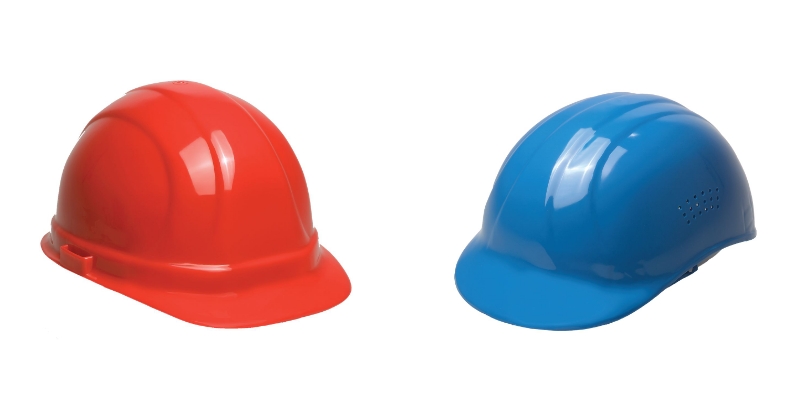It’s worth noting that not all head injuries may be reported or result in a claim for lost time. The AWCBC also reports that there were a total of 277,217 lost time claims due to workplace injuries in 2021.
The Importance of Head Protection

Head injuries can be serious and have long-lasting effects on a worker’s health and ability to work. It’s important for employers and workers to take steps to prevent head injuries in the workplace, such as wearing appropriate head protection equipment, following safety protocols, and reporting any potential hazards or incidents to their employer.
Head protection is important in the workplace because it can prevent or reduce the severity of head injuries that can occur due to workplace hazards. The head is a critical part of the body that contains the brain, which is responsible for controlling all bodily functions. Head injuries can have serious and long-lasting consequences, including permanent brain damage, disability, or even death.
In many workplaces, employees may be exposed to hazards such as falling objects, moving machinery, or electrical hazards, which can pose a risk of head injury. Head protection, such as hard hats or bump caps, can help to minimize the impact of these hazards and protect workers from head injuries.
Bump Caps vs Hard Hats
A bump cap and a hard hat are both types of head protection used in different settings. The primary difference between them is the level of protection they offer.

What is a Bump Cap?
A bump cap is lightweight head protection designed to protect the wearer’s head from minor bumps and scrapes that can occur in low-risk work environments. There are two types of bump caps available: one with an adjustable suspension that is inserted into a hard outer shell made of plastic or other materials, and the second type is a bump cap insert that is inserted into a six-panel baseball cap.
What are Bump Caps Used For?
Bump caps are designed for low-risk work environments where there is minimal chance of significant head injury. They are commonly used in industries such as food processing, automotive repair, and warehouse work.

Bump Cap Features:
- Lightweight: Bump caps are designed to be lightweight and comfortable to wear for extended periods.
- Two styles of bump caps:
- One style features an adjustable suspension that is inserted into a hard outer shell made of plastic or other materials.
- The second type is a bump cap insert that can be inserted into a six-panel baseball cap. These bump caps are intended to protect the wearer’s head from minor bumps and scrapes.
- Ventilation: Bump caps often have ventilation holes or mesh panels to allow air to circulate and keep the wearer cool.
- Adjustable strap: Bump caps typically have an adjustable strap at the back to ensure a secure and comfortable fit.
- Visor: Some bump caps have a short visor at the front to protect the wearer’s face from the sun or other hazards.
- Reflective strips: Some bump caps feature reflective strips or logos to improve visibility in low-light conditions.
It’s important to note that while a bump cap can provide some head protection from minor impacts, it is not designed to provide the same level of protection as a hard hat and should not be used in high-risk work environments.

Turn your baseball cap into a bump cap with Dentec’s Create A Cap™
What is a Hard Hat?
On the other hand, a hard hat provides more heavy-duty head protection that is designed to provide protection from significant impacts, such as falling objects or blows to the head. Hard hats have a rigid outer shell made of tough plastic or fibreglass and a suspension system. The hard hat shell and suspension work together to absorb the impact and reduce the force of a blow.

What are Hard Hats Used For?
Hard hats are designed for high-risk work environments where there is a greater risk of significant head injury. They are commonly used in construction sites, industrial settings, and other high-risk work environments.
Hard Hat Features:
- Rigid outer shell: Hard hats have a rigid outer shell made of tough plastic to protect the wearer’s head from impact and penetration.
- Suspension system: Hard hats have a suspension system inside the outer shell that helps absorb the force of a blow.
- Chin strap: A chin strap can be purchased to keep the hard hat securely on the wearer’s head, particularly important when working at heights.
- Sweatband: Bump caps and hard hats typically have a sweatband to absorb sweat and prevent it from getting into the wearer’s eyes.
- Ventilation: Some hard hats have ventilation holes or mesh panels to allow air to circulate and keep the wearer cool. However, hard hats with ventilation do not meet the highest level of dielectric protection in the standard, so please make sure you can use this type of hard hat in your application.
- Accessory slots: Many hard hats have slots on the sides or top for attaching accessories such as earmuffs, face shields, or headlamps.
- Colour-coding: Hard hats are often color-coded to identify different workers or departments on a job site. For example, safety managers might wear red hard hats, while electricians wear yellow ones.

Remember that hard hats are designed to protect the wearer from impacts and penetration, and they should be worn in high-risk work environments such as construction sites, industrial facilities, and mining operations. Hard hats should be inspected regularly for signs of wear and tear and replaced if damaged.
CSA Hard Hat Classifications
CSA Type 1 and Type 2 hard hats are two different classifications of protective headgear, and they differ mainly in terms of the areas of the head they protect and the type of impact and penetration they are designed to withstand.

CSA Type 1 Hard Hats
CSA Type 1 hard hats are designed to protect the wearer from impact to the top of the head, and they are commonly used in construction, mining, and other industries where there is a risk of objects falling from above. They provide protection against impact to the crown of the head and can either be Cap Style, which only has a brim at the front of the hat, or Full Brim Style, which has a brim that extends around the entire hat to shield the wearer’s face and neck from the sun and rain. Full Brim hard hats are sometimes referred to as Safari-style hard hats as well.
CSA Type 2 Hard Hats
CSA Type 2 hard hats, on the other hand, are designed to provide protection against impact and penetration to the crown and all sides of the head. They have a Styrofoam liner that allows the hard hat to meet the lateral impact and penetration testing requirements. They are commonly used in industries such as construction, mining, forestry, oil & gas etc., where workers may be at risk of lateral impact to the side of the head. Type 2 hard hats have a suspension system that is designed to absorb impacts from any direction. Type 2 Hard Hats are also available in Cap Style as well as Full Brim Style (Safari-style).
It’s important to note it is up to the provincial Occupational Health and Safety regulations to specify the type of head protection to be used in their respective workplaces. Most provinces require the use of a CSA-approved hard hat that meets the most current edition of the standard, CSA Z94.1 Industrial Head Protection. The choice of which type of hard hat to use depends on the specific hazards of the job site and the requirements. It is recommended to conduct a hazard assessment to ensure you select the appropriate head protection for your application.
If there are electrical hazards in the environment, an additional consideration is the class of dielectric protection your hard hat offers. There are three hard hat classifications to consider:
- Class C Hard Hats – These hard hats are not intended to provide protection against contact with electrical conductors and offer no dielectric protection.
- Class G Hard Hats – These hard hats are designed to reduce exposure to low voltage conductors and offer dielectric protection up to 2,200 volts (phase to ground).
- Class E Hard Hats – These hard hats are designed to reduce exposure to high voltage conductors and offer dielectric protection up to 20,000 volts (phase to ground). It’s important to note that this level of voltage protection applies specifically to the head and does not indicate the overall voltage protection provided to the user as a whole.
Employers Must Provide Appropriate Head Protection
Employers have a legal obligation to provide a safe work environment for their employees, and this includes ensuring that proper personal protective equipment, including head protection, is provided and used when necessary. By implementing effective head protection programs and supplying necessary training to workers, employers can help reduce the risk of head injuries and promote a safer work environment.
Dentec Safety is a leading manufacturer and distributor of safety products in the North America since 2004. Dentec Safety is dedicated to providing the highest quality safety products and solutions delivering enhanced value and comfort. Our expertise from decades of experience in Industrial Safety and our innovative design technologies have solidified us as thought leaders in the field. Protection and comfort are at the core of everything we do at Dentec. As a leading manufacturer of Safety Solutions, it is our mission to help organizations do the right thing, keep their employees safe and exceed Industry Health & Safety Standard.








